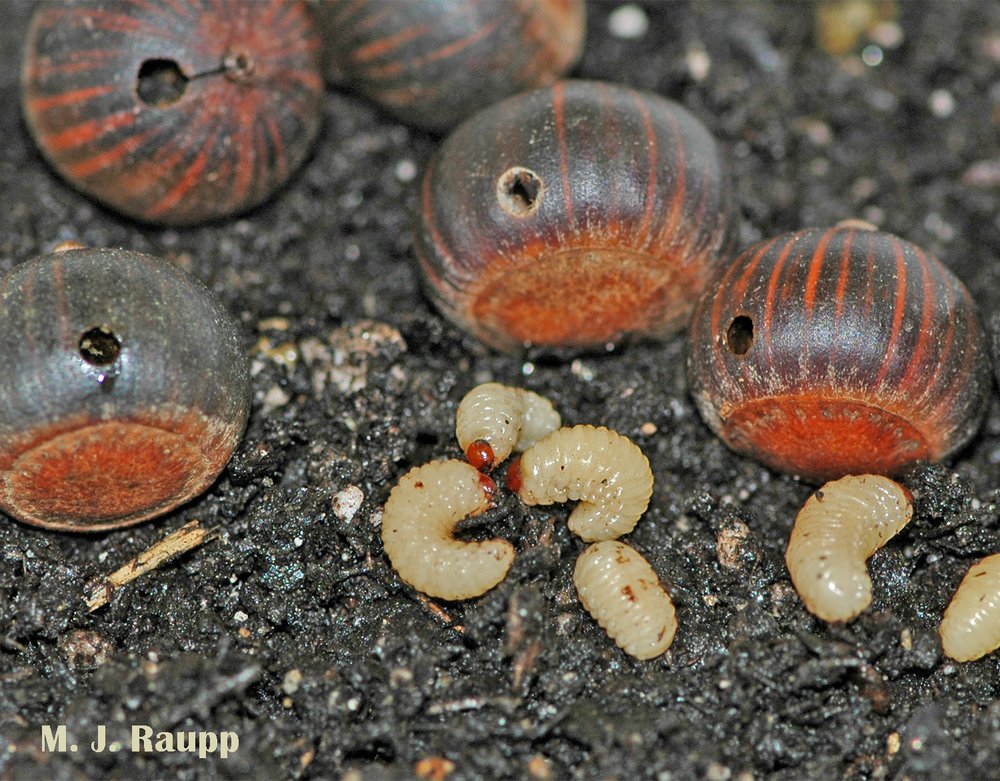
What’s up with the green berries on the holly tree?
Decorating homes and gifts with tiny sprigs of holly leaves and berries dates back to the Roman holiday of Saturnalia, the festival honoring Saturn at the time of the winter solstice. Saturn, the god of agriculture, abundance, and renewal reassured Romans that the darkness of the winter season would be followed by yet another year of light, prosperity, and plenty. And as we decorate our homes and gifts with holly, Mother Nature’s bounty of beautiful bright red berries on the holly tree attract many fascinating feathered friends such as mocking birds, blue jays, and cardinals to a winter feast. The berries provide a nutritious meal and, in return, the birds distribute the holly to new places by depositing seeds in their droppings.

This tiny fly larva and an associated fungus have the power to turn a holly berry from red to green, thereby enhancing chances of its own survival.
Recently, while photographing a gorgeous native holly, I spotted several holly berries distinctly green rather than scarlet red. Inside these fruits were tiny yellow maggots, larvae of the holly berry midge. In the spring when hollies were in bloom, the adult holly berry midge, a small mosquito-like fly, deposited eggs into the developing fruit of holly. These eggs hatched into larvae that fed within the berry. During the past growing season, the maggots consumed tissue of the fleshy fruit. In winter, larval development slows, but when the warmth of spring returns, these maggots complete development and become pupae from which emerge small midges that mate and deposit eggs into the developing berries, thereby completing the cycle of life.
Inside the holly berry, tiny holly berry midge larvae consume juicy plant cells. At less than 2 mm in length it’s hard to tell which end is which. In this video the head end is to the left and the rear end is to the right. Next year tiny flies called midges will emerge from the berry.

Adult holly berry midges are small mosquito-like flies. Note the papery pupal case left behind on the holly berry after the midge emerges.
For a small maggot, life in a holly berry is precarious. Its fate is tied to a red berry that advertises, "eat me" and hungry birds and squirrels happily oblige. These frugivores could literally eat the holly berry midge out of house and home. However, the larva of the holly berry midge has a clever trick to lessen its risks of disappearing down the gullet of a bird along with its fruity home. Berries infested by holly berry midge fail to turn red like normal holly berries do. The midge and an associated fungus prevent formation of bright red pigments by the berry. Infested berries remain green all winter. Through a series of detailed observations, researchers found that green holly berries were much less likely to be eaten by squirrels and birds than red berries on the same tree. By preventing the berry from turning red, holly berry midge has found a way to avoid the attention of fruit eating critters, thereby enhancing its chances for survival. So, as you deck your halls with boughs of holly, should you spy a green berry, you will understand why green is good for the cunning holly berry midge.
Bug of the Week is taking a Holiday break and will see you again in the New Year. Get ready to meet some interesting insects from the oldest rainforest on the planet in 2024. Have a wonderful Holiday Season and a joyous New Year!

Acknowledgements
We thank John Davidson for providing the inspiration and images for this week’s episode. The interesting references “Managing Insects and Mites on Woody Landscape Plants: an IPM Approach” by John Davidson and Michael Raupp, and “Selective Avoidance by Vertebrate Frugivores of Green Holly Berries Infested with a Cecidomyiid Fly (Diptera: Cecidomyiidae)” by Vera Krischik, Eric S. McCloud and John A. Davidson were used to prepare this episode.




